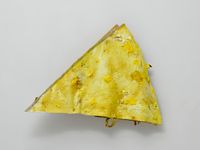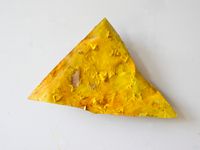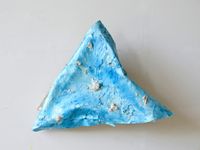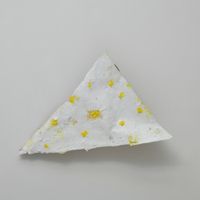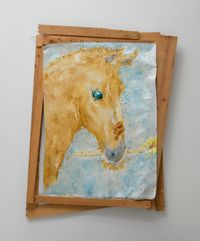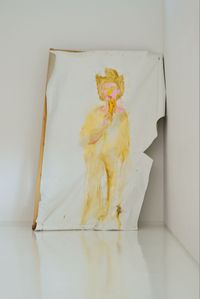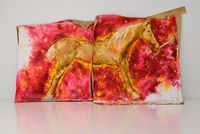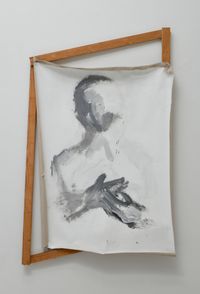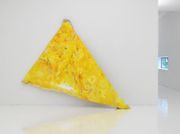Known for his messy and rugged hand-painted canvases, Tokyo-based artist Masato Kobayashi defies the conventions of painting predicated on applying paint onto neatly stretched canvases.
Read MoreMasato Kobayashi has exacted a fierce and independent reign over his chosen medium of painting since the mid-1980s. The Tokyo-born artist, indifferent to audience response, chose to explore his own definition of painting. Deciding that 'it is too late to paint after stretching canvas over a wooden frame', the artist began painting and stretching the canvas simultaneously.
Kobayashi's process involves first putting paint on one hand, right out of the tube, then rubbing the colours onto the canvas held in place by his other hand. Painting in this way, Masato Kobayashi see his process as integrating the physical body with the soul of painting. The folds, creases, and shape of the canvases, help to create a sense of space at the same time.
This distinct process results in images that range from painterly abstraction—as seen in the imposing earthy red Unnamed #7 (1997) and the blazing red and orange triangle of Unnamed #56 (2016)—to more detailed figurative images such as the relatively simple but tonally-modelled Nameless Horse (2014) and 'A Model of this planet', a series of expressive portraits begun in 2011.
Masato Kobayashi accentuates his paintings' rough appearances by awkwardly and haphazardly affixing the canvases to incomplete wooden frames with protruding nails. Often the canvases and frames are partially collapsed onto the floor. Sometimes there is no hint of a frame at all, such as A Model of this planet where the canvas is stretched between points on the floor and wall. The end result is striking for an art audience used to stretched canvases mounted on pristine white walls.
Masato Kobayashi's artworks can be found in several major public collections including The Museum of Contemporary Art Tokyo; the Sezon Museum of Modern Art, Nagano; The Vangi Sculpture Garden Museum, Shizuoka; and S.M.A.K. The Municipal Museum of Contemporary Art, Ghent.
Paint of this Planet, ShugoArts Online, Tokyo (2021); Artist and the Model, ShugoArts, Tokyo (2019); ART TODAY 2012, Sezon Museum of Modern Art, Nagano (2012); MASATO KOBAYASHI—The Paint of the Planet, Nariwa Museum, Okayama (2009); Starry Paint, stars of outer space by pure painting, Tensta konsthall, Spanga, Sweden (2004); A Son of Painting Masato Kobayashi, S.M.A.K., Ghent (2001); KOBAYASHI Masato, The Miyagi Museum of Art, Japan (2000).
Garden of Life: Eight Contemporary Artists Venture into Nature, Tokyo Metropolitan Teien Art Museum (2020); Weavers of Worlds−A Century of Flux in Japanese Modern / Contemporary Art, Museum of Contemporary Art Tokyo (2019); PHYSIOLOGY OF ART, OR MEDITATION OF TRANSCENDENTAL TASTE, Sezon, Museum of Modern Art, Nagano (2017); LOVE LOVE SHOW, Tomonotsu Museum, Fukuyama, Japan (2012); Skies and Stars: Celestial Images, National Museum of Modern Art, Tokyo (2007); Over the Edges, S.M.A.K., Ghent (2000); Light & Shadow - The Sense of Ephemerality, Hiroshima City Museum of Contemporary Art (1994); A Perspective on Contemporary Art: Color and/or Monochrome, The National Museum of Modern Art, Tokyo (1989).
Michael Irwin | Ocula | 2021
